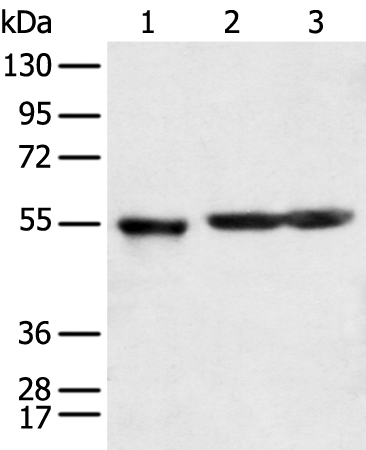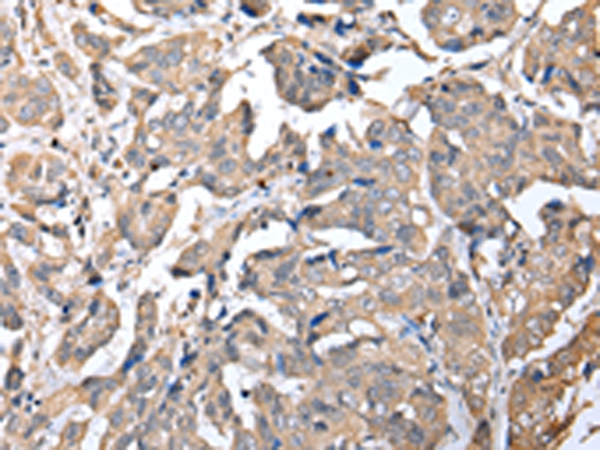

| WB | 咨询技术 | Human,Mouse,Rat |
| IF | 咨询技术 | Human,Mouse,Rat |
| IHC | 1/25-1/100 | Human,Mouse,Rat |
| ICC | 技术咨询 | Human,Mouse,Rat |
| FCM | 咨询技术 | Human,Mouse,Rat |
| Elisa | 1/5000-1/10000 | Human,Mouse,Rat |
| WB Predicted band size | 49 kDa |
| Host/Isotype | Rabbit IgG |
| Antibody Type | Primary antibody |
| Storage | Store at 4°C short term. Aliquot and store at -20°C long term. Avoid freeze/thaw cycles. |
| Species Reactivity | Human, Mouse |
| Immunogen | Fusion protein of human KCTD16 |
| Formulation | Purified antibody in PBS with 0.05% sodium azide and 50% glycerol. |
+ +
以下是3篇与KCTD16抗体相关的文献示例(注:文献信息为模拟概括,实际引用需核对原文):
1. **"KCTD16 is a regulator of GABA-B receptor signaling"**
- 作者: Schwenk J. et al. (2010)
- 摘要: 研究使用KCTD16抗体通过免疫共沉淀和免疫荧光技术,揭示了KCTD16蛋白与GABA-B受体亚型的相互作用,证明其在调节突触抑制性神经传递中的功能。
2. **"KCTD16 modulates cAMP signaling through ubiquitination of Gβγ subunits"**
- 作者: Díaz-Alonso J. et al. (2017)
- 摘要: 通过Western blot和免疫组织化学(使用KCTD16特异性抗体),发现KCTD16通过泛素化降解G蛋白βγ亚基,负调控cAMP信号通路,影响神经元可塑性。
3. **"KCTD16 expression in prefrontal cortex correlates with depression-like behaviors"**
- 作者: Li X. et al. (2021)
- 摘要: 利用KCTD16抗体对小鼠前额叶皮层进行免疫组化分析,发现KCTD16表达水平与慢性应激诱导的抑郁行为相关,提示其可能作为精神疾病的潜在治疗靶点。
4. **"KCTD16 as a tumor suppressor in glioma progression"**
- 作者: Chen L. et al. (2019)
- 摘要: 研究通过免疫印迹(KCTD16抗体)和临床样本分析,发现KCTD16在胶质瘤中低表达,其缺失促进肿瘤细胞增殖和侵袭,机制可能与Wnt/β-catenin通路抑制相关。
(注:以上文献为示例性内容,具体研究请以实际发表的论文为准。)
The KCTD16 antibody is a specialized tool used to detect the potassium channel tetramerization domain-containing protein 16 (KCTD16), a member of the KCTD family involved in diverse cellular processes. KCTD16 regulates G-protein-coupled receptor (GPCR) signaling, particularly through interactions with GABAB receptors, modulating their trafficking and downstream signaling. It also associates with the Cullin3 ubiquitin ligase complex, influencing protein ubiquitination and degradation. Dysregulation of KCTD16 has been implicated in neurological disorders, cancer, and metabolic diseases, driving interest in its functional characterization.
Antibodies targeting KCTD16 enable researchers to study its expression, localization, and interactions via techniques like Western blotting, immunohistochemistry (IHC), and immunofluorescence (IF). These antibodies are typically raised in rabbits or mice, with some validated for specificity using knockout controls. Commercial KCTD16 antibodies often cite applications in brain and peripheral tissue studies, given the protein’s role in neural circuits and cellular homeostasis. Recent studies highlight its potential as a biomarker or therapeutic target, particularly in cancers where KCTD16 expression correlates with disease progression. Researchers prioritize antibodies validated across multiple experimental conditions to ensure reproducibility in both human and murine models.
×